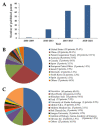Amazing Fungi for Eco-Friendly Composite Materials: A Comprehensive Review
- PMID: 36012830
- PMCID: PMC9460913
- DOI: 10.3390/jof8080842
Amazing Fungi for Eco-Friendly Composite Materials: A Comprehensive Review
Abstract
The continually expanding use of plastic throughout our world, along with the considerable increase in agricultural productivity, has resulted in a worrying increase in global waste and related environmental problems. The reuse and replacement of plastic with biomaterials, as well as the recycling of agricultural waste, are key components of a strategy to reduce plastic waste. Agricultural waste is characterized as lignocellulosic materials that mainly consist of cellulose, hemicellulose, and lignin. Saprobe fungi are able to convert agricultural waste into nutrients for their own growth and to facilitate the creation of mycelium-based composites (MBC) through bio-fabrication processes. Remarkably, different fungal species, substrates, and pressing and drying methods have resulted in varying chemical, mechanical, physical, and biological properties of the resulting composites that ultimately vary the functional aspects of the finished MBC. Over the last two decades, several innovative designs have produced a variety of MBC that can be applied across a range of industrial uses including in packaging and in the manufacturing of household items, furniture, and building materials that can replace foams, plastics, and wood products. Materials developed from MBC can be considered highly functional materials that offer renewable and biodegradable benefits as promising alternatives. Therefore, a better understanding of the beneficial properties of MBC is crucial for their potential applications in a variety of fields. Here, we have conducted a brief review of the current findings of relevant studies through an overview of recently published literature on MBC production and the physical, mechanical, chemical, and biological properties of these composites for use in innovative architecture, construction, and product designs. The advantages and disadvantages of various applications of mycelium-based materials (MBM) in various fields have been summarized. Finally, patent trends involving the use of MBM as a new and sustainable biomaterial have also been reviewed. The resulting knowledge can be used by researchers to develop and apply MBC in the form of eco-friendly materials in the future.
Keywords: agricultural waste; biomaterial; innovative design; mycelium-based composite; saprobic fungi.
Conflict of interest statement
The authors declare no conflict of interest.
Figures






References
-
- Moore C. Plastic Pollution. [(accessed on 30 March 2022)]. Available online: https://www.britannica.com/science/plastic-pollution.
-
- Shrivastava A. Introduction to Plastics Engineering. William Andrew; Norwich, CT, USA: 2018. Introduction to plastics; pp. 1–16.
-
- Nkwachukwu O.I., Chima C.H., Ikenna A.O., Albert L. Focus on potential environmental issues on plastic world towards a sustainable plastic recycling in developing countries. Int. J. Ind. Chem. 2013;4:34. doi: 10.1186/2228-5547-4-34. - DOI
-
- Chow C.F., So W.M.W., Cheung T.Y., Yeung S.K.D. Plastic waste problem and education for plastic waste management. In: Kong S.C., Wong T.L., Yang M., Chow C.F., Tse K.H., editors. Emerging Practices in Scholarship of Learning and Teaching in a Digital Era. Springer; Singapore: 2017. pp. 125–140.
Publication types
LinkOut - more resources
Full Text Sources
Other Literature Sources

